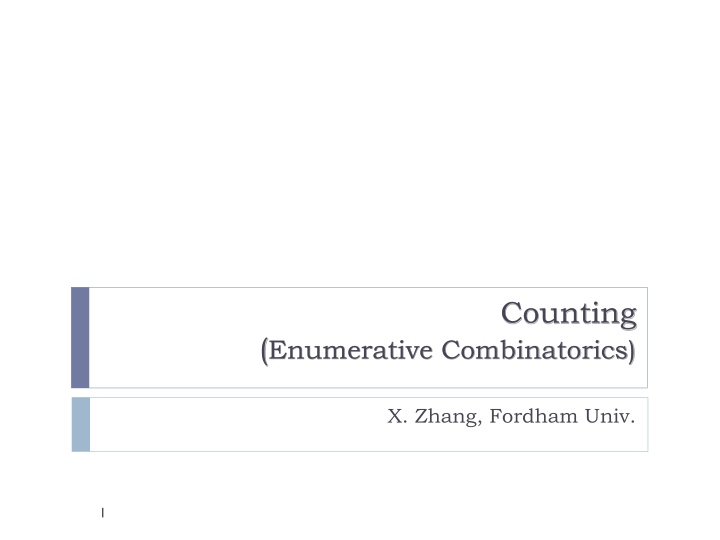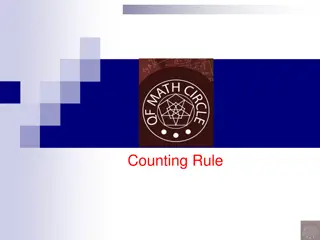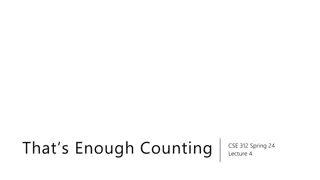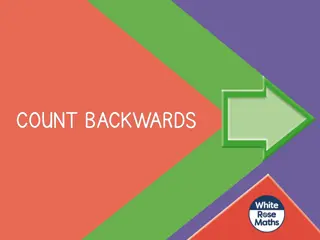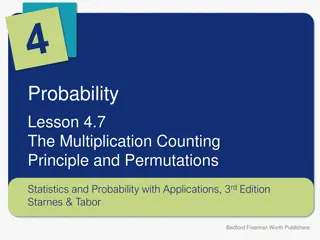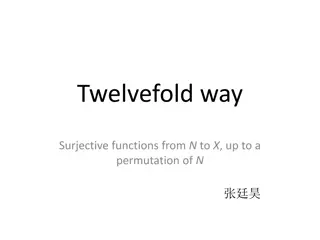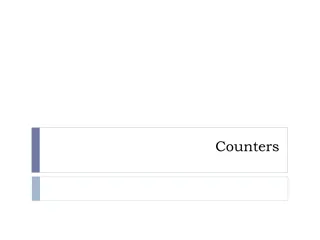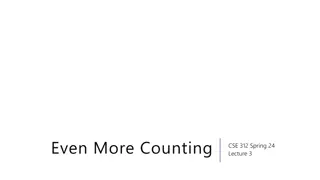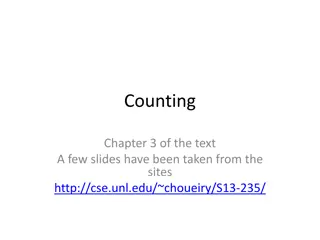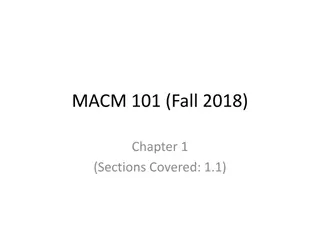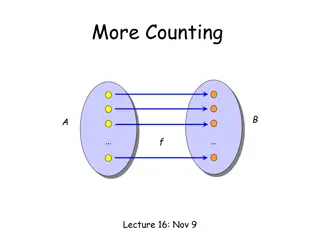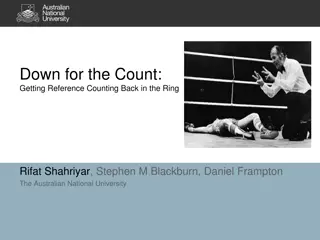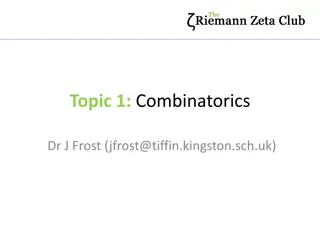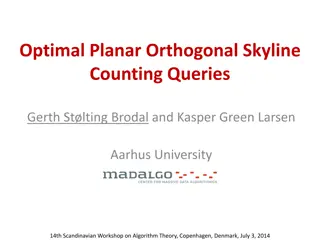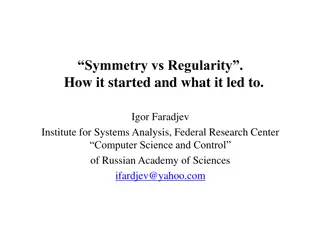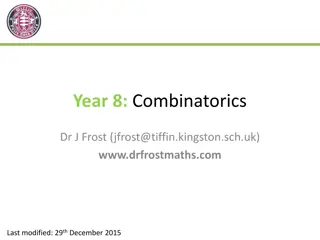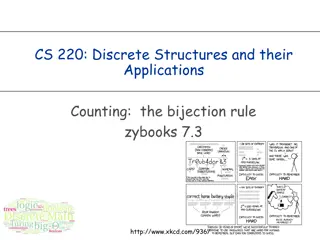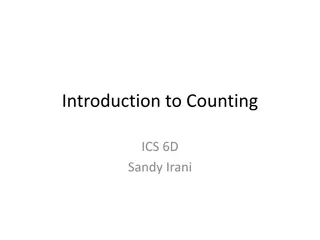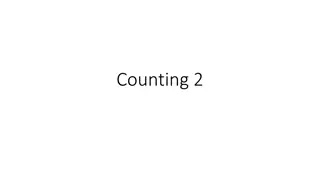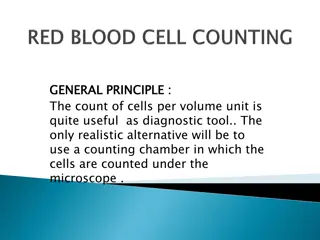Counting Strategies and Examples in Enumerative Combinatorics
Understanding counting principles in enumerative combinatorics is essential for solving mathematical problems involving permutations and combinations. The concepts discussed include calculating probabilities, determining the number of outcomes, and applying counting rules to various scenarios such as winning probabilities in lottery games, determining the number of possible license plates, and seating arrangements. Examples illustrate how to apply these counting strategies effectively.
Download Presentation

Please find below an Image/Link to download the presentation.
The content on the website is provided AS IS for your information and personal use only. It may not be sold, licensed, or shared on other websites without obtaining consent from the author.If you encounter any issues during the download, it is possible that the publisher has removed the file from their server.
You are allowed to download the files provided on this website for personal or commercial use, subject to the condition that they are used lawfully. All files are the property of their respective owners.
The content on the website is provided AS IS for your information and personal use only. It may not be sold, licensed, or shared on other websites without obtaining consent from the author.
E N D
Presentation Transcript
Counting (Enumerative Combinatorics) X. Zhang, Fordham Univ. 1
Chance of winning ? What s the chances of winning New York Mega- million Jackpot just pick 5 numbers from 1 to 56, plus a mega ball number from 1 to 46, then you could win biggest potential Jackpot ever ! If your 6-number combination matches winning 6-number combination (5 winning numbers plus the Mega Ball), then you win First prize jackpot. There are many possible ways to choose 6-number Only one of them is the winning combination If each 6-number combination is equally likely to be the winning combination Then the prob. of winning for any 6-number is 1/X 2
Counting How many bits are need to represent 26 different letters? How many different paths are there from a city to another, giving the road map? 3
Counting rule #1: just count it If you can count directly the number of outcomes, just count them. For example: How many ways are there to select an English letter ? 26 as there are 26 English letters How many three digits integers are there ? These are integers that have value ranging from 100 to 999. How many integers are there from 100 to 999 ? 999-100+1=900 4
Example of first rule How many integers lies within the range of 1 and 782 inclusive ? 782, we just know this ! How many integers lies within the range of 12 and 782 inclusive ? Well, from 1 to 782, there are 782 integers Among them, there are 11 number within range from 1 to 11. So, we have 782-(12-1)=782-12+1 numbers between 12 and 782 5
Quick Exercise So the number of integers between two integers, S (smaller number) and L (larger number) is: L-S+1 How many integers are there in the range 123 to 928 inclusive ? How many ways are there to choose a number within the range of 12 to 23, inclusive ? 6
A little more complex problems How many possible license plates are available for NY state ? 3 letters followed by 4 digits (repetition allowed) How many 5 digits odd numbers if no digits can be repeated ? How many ways are there to seat 10 guests in a table? How many possible outcomes are there if draw 2 cards from a deck of cards ? Key: all above problems ask about # of combinations/arrangements of people/digits/letters/ 7
How to count ? Count in a systematical way to avoid double-counting or miss counting Ex: to count num. of students present First count students on first row, second row, First count girls, then count boys 8
How to count (2)? Count in a systematical way to avoid double-counting or miss counting Ex: to buy a pair of jeans Styles available: standard fit, loose fit, boot fit and slim fit Colors available: blue, black How many ways can you select a pair of jeans ? 9
Use Table to organize counting Fix color first, and vary styles Table is a nature solution What if we can also choose size, Medium, Small or Large? 3D table ? 10
Selection/Decision tree style color color color color Node: a feature/variable Branch: a possible selection for the feature Leaf: a configuration/combination 11
Lets try an example Enumerate all 3-letter words formed using letters from word cat assuming each letter is used once. How would you do that ? Choose a letter to put in 1st position, 2nd and 3rd position 12
Exercises Use a tree to find all possible ways to buy a car Color can be any from {Red, Blue, Silver, Black} Interior can be either leather or fiber Engine can be either 4 cylinder or 6 cylinder How many different outcomes are there for a best of 3 tennis match between player A and B? Whoever wins 2 games win the match 13
Terminology When buying a pair of jean, one can choose style and color We call style and color features/variables For each feature, there is a set of possible choices/options For style , the set of options is {standard, loose, boot, slim} For color , the set of options is {blue,black} Each configuration, i.e., standard-blue, is called an outcome/possibility 14
Outline on Counting Just count it Organize counting: table, trees Multiplication rule Permutation Combination Addition rule, Generalized addition rule Exercises 15
Counting rule #2: multiplication rule If we have two features/decisions C1 and C2 C1 has n1 possible outcomes/options C2 has n2 possible outcomes/options Then total number of outcomes is n1*n2 In general, if we have k decisions to make: C1 has n1 possible options Ck has nk possible options then the total number of outcomes is n1*n2* *nk. AND rule : You must make all the decisions i.e., C1, C2, , Ck must all occur C1 n1 C2 C2 C2 n2 n2 16
Jean Example Problem Statement Two decisions to make: C1=Chossing style, C2=choosing color Options for C1 are {standard fit, loose fit, boot fit, slim fit}, n1=4 Options for C2 are {black, blue}, n2=2 To choose a jean, one must choose a style and choose a color C1 and C2 must both occur, use multiplication rule So the total # of outcomes is n1*n2=4*2=8. 17
Coin flipping Flip a coin twice and record the outcome (head or tail) for each flip. How many possible outcomes are there ? Problem statement: Two steps for the experiment, C1= first flip , C2= second flip Possible outcomes for C1 is {H, T}, n1=2 Possible outcomes for C2 is {H,T}, n2=2 C1 occurs and C2 occurs: total # of outcomes is n1*n2=4 18
License Plates Suppose license plates starts with two different letters, followed by 4 letters or numbers (which can be the same). How many possible license plates ? Steps to choose a license plage: Pick two different letters AND pick 4 letters/numbers. C1: Pick a letter C2: Pick a letter different from the first C3,C4,C5,C6: Repeat for 4 times: pick a number or letter Total # of possibilities: 26*25*36*36*36*36 = 1091750400 Note: the num. of options for a feature/variable might be affected by previous features 19
Exercises: In a car racing game, you can choose from 4 difficulty level, 3 different terrains, and 5 different cars, how many different ways can you choose to play the game ? How many ways can you arrange 10 different numbers (i.e., put them in a sequence)? 20
Relation to other topics It might feel like that we are topics-hopping Set, logic, function, relation Counting: What is being counted ? A finite set, i.e., we are evaluate some set s cardinality when we tackle a counting problem How to count ? So rules about set cardinality apply ! Inclusion/exclusion principle Power set cardinality Cartisian set cardinality 21
Learn new things by reviewing old Sets cardinality: number of elements in set |AxB| = |A| x |B| The number of diff. ways to pair elements in A with elements in B, i.e., |AxB|, equals to |A| x |B| Example A={standard, loose, boot}, the set of styles B={blue, black}, the set of colors AxB= {(standard, blue), (standard, black), (loose, blue), (loose, black), (boot, blue), (boot, black)}, the set of different jeans |AxB|: # of different jeans we can form by choosing from A the style, and from B the color 22
Seating problem How many different ways are there to seat 5 children in a row of 5 seats? Pick a child to sit on first chair Pick a child to sit on second chair Pick a child to sit on third chair The outcome can be represented as an ordered list: e.g. Alice, Peter, Bob, Cathy, Kim By multiplication rule: there are 5*4*3*2*1=120 different ways to sit them. Note, Pick a chair for 1stchild etc. also works 24
Job assignment problem How many ways to assign 5 diff. jobs to 10 volunteers, assuming each person takes at most one job, and one job assigned to one person ? Pick one person to assign to first job: 10 options Pick one person to assign to second job: 9 options Pick one person to assign to third job: 8 options In total, there are 10*9*8*7*6 different ways to go about the job assignments. 25
Permutation Some counting problems are similar How many ways are there to arrange 6 kids in a line ? How many ways to assign 5 jobs to 10 volunteers, assuming each person takes at most one job, and one job assigned to one person ? How many different poker hands are possible, i.e. drawing five cards from a deck of card where order matters ? 26
Permutation A permutation of objects is an arrangement where order/position matters. Note: arrangement implies each object cannot be picked more than once. Seating of children Positions matters: Alice, Peter, Bob, Cathy, Kim is different from Peter, Bob, Cathy, Kim, Alice Job assignment: choose 5 people out of 10 and arrange them (to 5 jobs) Select a president, VP and secretary from a club 27
Permutations Generally, consider choosing r objects out of a total of n objects, and arrange them in r positions. n objects (n gifts) 1 2 3 r-1 r r positions (r behaving Children) 28
Counting Permutations Let P(n,r) be the number of permutations of r items chosen from a total of n items, where r n n objects and r positions Pick an object to put in 1st position, # of ways: Pick an object to put in 2nd position, # of ways: Pick an object to put in 3rd position, # of ways: Pick an object to put in r-th position, # of ways: By multiplication rule, n n-1 n-2 n-(r-1) 29
Note: factorial n! stands for n factorial , where n is positive integers, is defined as Now 30
Examples How many five letter words can we form using distinct letters from set {a,b,c,d,e,f,g,h} ? It s a permutation problem, as the order matters and each object (letter) can be used at most once. P(8,5) 31
Examples How many ways can one select a president, vice president and a secretary from a class of 28 people, assuming each student takes at most one position ? A permutation of 3 people selecting from 28 people: P(28,3)=28*27*26 32
Exercises What does P(10,2) stand for ? Calculate P(10,2). How about P(12,12)? How many 5 digits numbers are there where no digits are repeated and 0 is not used ? 33
Examples: die rolling If we roll a six-sided die three times and record results as an ordered list of length 3 How many possible outcomes are there ? 6*6*6=216 How many possible outcomes have different results for each roll ? 6*5*4 How many possible outcomes do not contain 1 ? 5*5*5=125 34
Combinations Many selection problems do not care about position/order from a committee of 3 from a club of 24 people Santa select 8 million toys from store Buy three different fruits Combination problem: select r objects from a set of n distinct objects, where order does not matter. 35
Combination formula C(n,r): number of combinations of r objects chosen from n distinct objects (n>=r) Ex: ways to buy 3 different fruits, choosing from apple, orange, banana, grape, kiwi: C(5,3) Ex: ways to form a committee of two people from a group of 24 people: C(24,2) Ex: Number of subsets of {1,2,3,4} that has two elements: C(4,2) Next: derive formula for C(n,r) 36
Deriving Combination formula How many ways are there to form a committee of 2 for a group of 24 people ? Order of selection doesn t matter Let s try to count: There are 24 ways to select a first member And 23 ways to select the second member So there are 24*23=P(24,2) ways to select two peoples in sequence In above counting, each two people combination is counted twice e.g., For combination of Alice and Bob, we counted twice: (Alice, Bob) and (Bob, Alice). To delete overcounting P(24,2)/2 37
General formula when selecting r items out of n distinct items If order of selection matters, there are P(n,r) ways For each combination (set) of r items, they have been counted many times, as they can be selected in different orders: For r items, there are P(r,r) different possible selection order e.g., {Alice, Bob} can be counted twice: (Alice, Bob) and (Bob, Alice). (if r=2) Therefore, each set of r items are counted P(r,r) times. The # of combinations is: 38
A few exercise with C(n,r) Calculate C(7,3) What is C(n,n) ? How about C(n,0)? Show C(n,r)=C(n,n-r). 39
Committee Forming How many different committees of size 7 can be formed out of 20-person office ? C(20,7) Three members (Mary, Sue and Tom) are carpooling. How many committees meet following requirement ? All three of them are on committee: None of them are on the committee: C(20-7,4) C(20-7,7) 40
Outline on Counting Just count it Organize counting: table, trees Multiplication rule Permutation Combination Addition rule, Generalized addition rule Exercises 41
Set Related Example How many subsets of {1,2,3,4,5,6} have 3 elements ? C(6,3) How many subsets of {1,2,3,4,5,6} have an odd number of elements ? Either the subset has 1, or 3, or 5 elements. C(6,1)+C(6,3)+C(6,5) 42
Knapsack Problem There are n objects The i-th object has weight wi, and value vi You want to choose objects to take away, how many possible ways are possible ? 2*2* *2=2n C(n,0)+C(n,1)+ +C(n,n) Knapsack problem: You can only carry W pound stuff What shall you choose to maximize the value ? Classical NP hard problem 43
Addition Rule If the events/outcomes that we count can be decomposed into k cases C1, C2, , Ck, each having n1, n2, nk, possible outcomes respectively, (either C1 occurs, or C2 occurs, or C3occurs, . or Ck occurs) Then the total number of outcomes is n1+n2+ +nk . C3 C1 C2 C4 44
Key to Addition Rule Decompose what you are counting into simpler, easier to count scenarios, C1, C2, , Ck Count each scenario separately, n1,n2, ,nk Add the number together, n1+n2+ +nk C3 C1 C2 C4 45
Examples: die rolling If we roll a six-sided die three times and record results as an ordered list of length 3 How many of the possible outcomes contain exactly one 1, e.g. 1,3,2 or, 3,2,1, or 5,1,3 ? Let s try multiplication rule by analyzing what kind of outcomes satisfy this ? First roll: 6 possible outcomes Second roll: # of outcomes ? If first roll is 1, second roll can be any number but 1 If first roll is not 1, second roll can be any number Third roll: # of outcomes ?? 46
Examples: die rolling If we roll a six-sided die three times and record results as an ordered list of length 3 how many of the possible outcomes contain exactly one 1 ? Let s try to consider three different possibilities: The only 1 appears in first roll, C1 The only1 appears in second roll, C2 The only1 appears in third roll, C3 We get exactly one 1 if C1 occurs, or C2 occurs, or C3 occurs Result: 5*5+5*5+5*5=75 47
Examples: die rolling If we roll a six-sided die three times, how many of the possible outcomes contain exactly one 1 ? Let s try another approach : First we select where 1 appears in the list 3 possible ways Then we select outcome for the first of remaining positions 5 possible ways Then we select outcome for the second of remaining positions 5 possible ways Result: 3*5*5=75 48
Example: Number counting How many positive integers less than 1,000 consists only of distinct digits from {1,3,7,9} ? To make such integers, we either Pick a digit from set {1,3,7,9} and get an one-digit integer Take 2 digits from set {1,3,7,9} and arrange them to form a two-digit integer permutation of length 2 with digits from {1,3,7,9}. Take 3 digits from set {1,3,7,9} and arrange them to form a 3-digit integer a permutation of length 3 with digits from {1,3,7,9}. 49
Example: Number Counting Use permutation formula for each scenario (event) # of one digit number: P(4,1)=3 # of 2 digit number: P(4,2)=4*3=12 # of 3 digit number: P(4,3)=4*3*2=24 Use addition rule, i.e., OR rule Total # of integers less than 1000 that consists of {1,3,7,9}: 3+12+24=39 50
